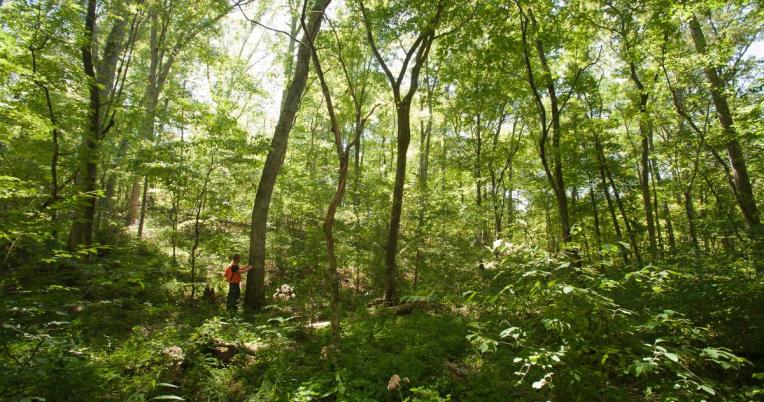Why we care
More than 500 species of ground flora plants, including grasses, sedges, wildflowers, ferns, vines, shrubs, and tree seedlings, have been found on MOFEP! Native plants are vital food, shelter, and nesting resources for pollinators, birds, and other wildlife species. They also help reduce erosion, cycle nutrients, filter air and water, store carbon, and help resist encroachment by nonnative, invasive plants. Nonnative plants provide little to no benefit to insects and wildlife, so if native plants disappear from an area so do the species that rely on them. These are just some of the reasons it is important for us to understand how plants respond to forest management activities.
Objectives
Evaluate the impacts of forest management on the richness, diversity, abundance, and composition of ground flora plant species and soft mast abundance.
Project design
- Inventories are conducted on 648 half-acre vegetation plots that are randomly placed across the nine MOFEP sites. These are the same vegetation plots used to measure woody vegetation.
- Ground flora species are recorded on 16 one-square-meter quadrats, systematically nested within the half-acre plot.
- Multiple sampling events occur in the years immediately pre- and post-harvest, and at least one additional sampling event occurs in the interim between harvests. Sampling occurs from June through early September.
- Every ground flora plant is identified to species level. Abundance is assessed using percent cover and soft mast stems are counted.
Early results
- There were no significant changes in the no harvest sites; species richness, diversity, and abundance of ground flora and soft mast berries remained low.
- Increases in richness, diversity, abundance, and quality occurred in even- and uneven-aged sites 3-5 years after harvest.
- What is floral quality? – Each ground flora species has been given a ranking to help botanists give a relative condition or “quality” of an area. These rankings are based on a species tolerance to different conditions or habitats. For example, plants that can survive almost anywhere are given a lower quality ranking compared to plants that require very specific conditions to survive. Areas with many “high quality” species are important for conservation.
- Over time, richness, diversity, abundance, and quality declined as the new stand developed, especially as clearcut stands entered the stem exclusion stage (i.e., when the dense regenerating young trees fill the available growing space and block light from reaching the forest floor).
- High quality species increased, but average floral quality declined slightly due to a greater increase of low-quality native species.
- Nonnative species did not increase on vegetation plots, but new occurrences of nonnative invasive species appeared on some log landings and harvest access trails.
- Soft mast berries increased dramatically in clearcut stands within even-aged sites in response to increased sunlight.
Management recommendations
- Prevent introduction of new invasive plant seeds via logging equipment and vehicles.
- Ensure equipment, boots, and vehicles are adequately cleaned of mud and debris prior to entering sites.
- Monitor and remove invasive plants before they can establish and spread.
- Roads and trails will be the primary introduction point for most invasive plants; however, some seeds can be dispersed by birds and other animals to areas far from human activity.
- The longer an invasive population is left to produce seed and spread the more time and money it will require to remove.
- Watch for decreases in high quality native species.
- Clearcut areas should continue to remain small and scattered on the landscape.
- Devote resources to glade management to increase ground flora diversity, including prescribed burning and cedar removal.
MOFEP Ground Flora Publications (PDF, 147 KB)
List of MOFEP Ground Flora publications
Published on May 05, 2021Response of Peromyscus mice to the effects of timber harvesting in Ozark oak-hickory forests in southeast Missouri (PDF, 565 KB)
Small mammal responses to timber harvest techniques and soft mast availability
Presented on Aug 05, 2021
